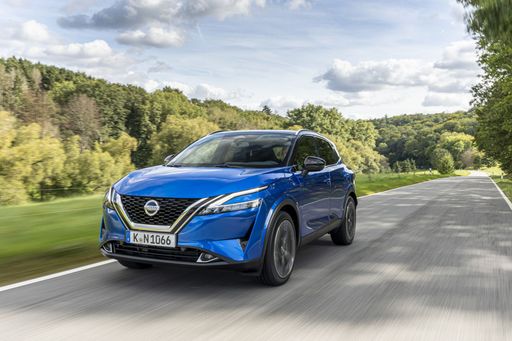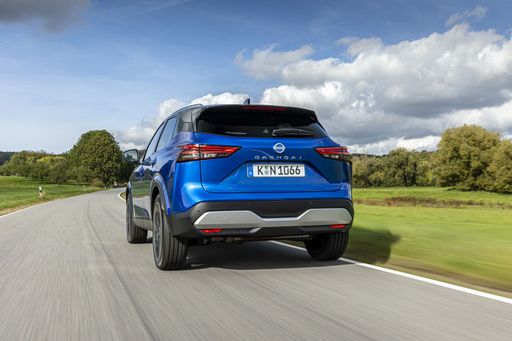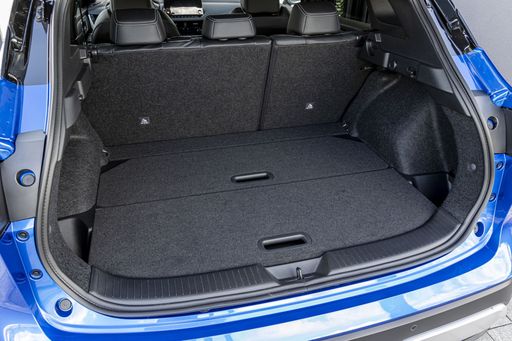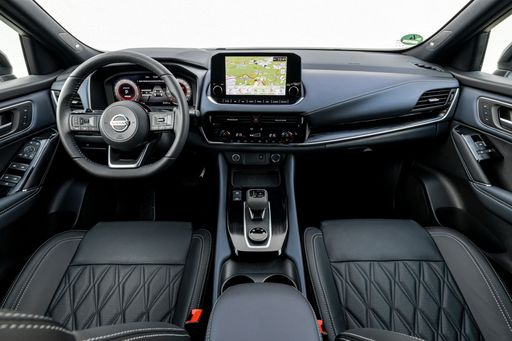Nissan Qashqai VS Renault R4 – Specs, Efficiency & Price Comparison
Which model is the better choice – the Nissan Qashqai or the Renault R4? We compare performance (190 HP vs 150 HP), boot capacity (504 L vs 420 L), efficiency (5.10 L vs ), and of course, the price (29400 £ vs 25200 £).
Find out now which car fits your needs better!
The Nissan Qashqai (SUV) is powered by a Petrol MHEV or Full Hybrid engine and comes with a Manuel or Automatic transmission. In comparison, the Renault R4 (SUV) features a Electric engine and a Automatic gearbox.
When it comes to boot capacity, the Nissan Qashqai offers 504 L, while the Renault R4 provides 420 L – depending on what matters most to you. If you’re looking for more power, you’ll need to decide whether the 190 HP of the Nissan Qashqai or the 150 HP of the Renault R4 suits your needs better.
There are also differences in efficiency: 5.10 L vs . In terms of price, the Nissan Qashqai starts at 29400 £, while the Renault R4 is available from 25200 £.
Compare all the key specs now and find out which model fits your lifestyle best!
Nissan Qashqai
The Nissan Qashqai stands out in the compact SUV market with its sleek design and versatile features. Its smooth ride and refined interior make it a popular choice for both city driving and weekend adventures. Advanced safety technologies and user-friendly infotainment add to its appeal, ensuring a comfortable and secure driving experience for all passengers.
details @ Nissan
@ Nissan
 @ Nissan
@ Nissan
 @ Nissan
@ Nissan
 @ Nissan
@ Nissan
 @ Nissan
@ Nissan
Renault R4
The Renault R4, affectionately known as the "R4," is a quintessential symbol of French automotive simplicity and practicality. This classic compact car, originally introduced in the early 1960s, won over numerous enthusiasts with its versatile design and dependable performance. Its no-frills charm and robust build made it a beloved choice for rural drivers and city dwellers alike, cementing its status as an iconic piece of automotive history.
details

|
|
|
|
|
Costs and Consumption |
|
|---|---|
|
Price
29400 - 42500 £
|
Price
25200 - 31200 £
|
|
Consumption L/100km
5.1 - 6.8 L
|
Consumption L/100km
-
|
|
Consumption kWh/100km
-
|
Consumption kWh/100km
-
|
|
Electric Range
-
|
Electric Range
322 - 409 km
|
|
Battery Capacity
-
|
Battery Capacity
40 - 52 kWh
|
|
co2
116 - 154 g/km
|
co2
0 g/km
|
|
Fuel tank capacity
55 L
|
Fuel tank capacity
-
|
Dimensions and Body |
|
|---|---|
|
Body Type
SUV
|
Body Type
SUV
|
|
Seats
5
|
Seats
5
|
|
Doors
5
|
Doors
5
|
|
Curb weight
1420 - 1665 kg
|
Curb weight
1485 - 1537 kg
|
|
Trunk capacity
479 - 504 L
|
Trunk capacity
420 L
|
|
Length
4425 mm
|
Length
4144 mm
|
|
Width
1835 mm
|
Width
1808 mm
|
|
Height
1625 mm
|
Height
1552 mm
|
|
Payload
466 - 520 kg
|
Payload
410 - 443 kg
|
Engine and Performance |
|
|---|---|
|
Engine Type
Petrol MHEV, Full Hybrid
|
Engine Type
Electric
|
|
Transmission
Manuel, Automatic
|
Transmission
Automatic
|
|
Transmission Detail
Schaltgetriebe
|
Transmission Detail
-
|
|
Drive Type
Front-Wheel Drive, All-Wheel Drive
|
Drive Type
Front-Wheel Drive
|
|
Power HP
140 - 190 HP
|
Power HP
122 - 150 HP
|
|
Acceleration 0-100km/h
7.9 - 10.2 s
|
Acceleration 0-100km/h
8.2 - 9.2 s
|
|
Max Speed
170 - 206 km/h
|
Max Speed
150 km/h
|
|
Torque
240 - 330 Nm
|
Torque
225 - 245 Nm
|
|
Number of Cylinders
3 - 4
|
Number of Cylinders
-
|
|
Power kW
103 - 140 kW
|
Power kW
90 - 110 kW
|
|
Engine capacity
1332 - 1497 cm3
|
Engine capacity
-
|
General |
|
|---|---|
|
Model Year
2024
|
Model Year
2025
|
|
CO2 Efficiency Class
E, D
|
CO2 Efficiency Class
A
|
|
Brand
Nissan
|
Brand
Renault
|
Nissan Qashqai
Exploring the New Nissan Qashqai: A Masterclass in Innovation and Performance
The Nissan Qashqai stands as a testament to the brand's continuous evolution in the competitive SUV market. Building on its robust reputation, the latest models bring a blend of style, efficiency, and groundbreaking technology that cater to the modern driver's needs. As we delve into the technical nuances and innovative features, it becomes evident why the Qashqai remains a top contender in its segment.
Powertrain and Efficiency: A Harmonious Balance
The latest Nissan Qashqai models feature an advanced range of powertrain options, including both mild-hybrid and full-hybrid systems. The 1.3 DIG-T MHEV engines provide power outputs ranging from 140 to 158 PS, ensuring a responsive driving experience while maintaining a remarkable fuel efficiency of 6.3 L/100km for automatic front-wheel drive versions. The full-hybrid 1.5 VC-T e-POWER delivers an impressive 190 PS while achieving a fuel efficiency of just 5.1 L/100km, demonstrating Nissan's commitment to ecological innovation.
Advanced Transmission Systems
Drivers can choose between manual or automatic transmissions, tailored to their driving style. The manual gearbox offers a tactile driving experience, while the automatic options, including a CVT and reduction gear transmission, ensure seamless power delivery and heightened efficiency. For those who seek greater traction and stability, all-wheel drive configurations are also available, enhancing the Qashqai's versatility.
High-Tech Interior: Comfort Meets Connectivity
The Qashqai's interior is a sanctuary of technology and comfort. The SUV features a user-friendly infotainment system with a touchscreen interface, compatible with both Android Auto and Apple CarPlay. The seamless integration of technology extends to advanced driver-assistance systems (ADAS) that include ProPILOT with Navi-link, enhancing convenience and safety during long drives or urban manoeuvres.
Performance and Dynamics: The Driving Experience
When it comes to performance, the Qashqai does not compromise. With acceleration from 0-100 km/h in as little as 7.9 seconds in the more powerful hybrid editions, and a top speed ranging from 170 to 206 km/h, Nissan ensures that excitement is part and parcel of the Qashqai driving experience. This balance of power and control is complemented by a well-tuned suspension system and precise steering response, providing a confident drive whether on highways or country lanes.
Design and Practicality: Where Form Meets Function
Sporting an aerodynamic silhouette, the Qashqai exudes a modern vibe that is both eye-catching and functional. Its dimensions, with a length of 4425 mm and a width of 1835 mm, provide ample cabin space for five passengers, along with a versatile boot capacity of up to 504 litres. These aspects make it an ideal choice for families and adventurers alike.
Conclusion: A Forward-Thinking Choice
The Nissan Qashqai remains a steadfast choice for those seeking an SUV that blends innovative technology with everyday practicality. With its advanced hybrid options and cutting-edge features, it not only meets but often exceeds the demands of today's environmentally conscious and tech-savvy drivers. As Nissan continues to push boundaries, the Qashqai stands as a beacon of what modern SUVs can achieve.
Renault R4
The Timeless Charm of the Renault R4: A Journey from Classic to Contemporary
The Renault R4 is an iconic name that echoes through automotive history, its roots deeply entrenched in the legacy of Renault's innovative engineering. As we usher into 2025, the classic appeal of the R4 meets modern innovation with the latest electric versions. Let's explore what makes the Renault R4 a remarkable blend of nostalgia and technology.
A Classic Reinvented: The Renault R4 Specifications
The Renault R4 is primarily an SUV, showcasing its versatility as both a practical family car and an adventurous road companion. The latest model comes with the robustness and aesthetic appeal we've come to expect from Renault, enhanced by cutting-edge electric powertrains.
Designed as an electric vehicle, the new Renault R4 variations come with different battery capacities ranging from 40 kWh to 52 kWh. These provide impressive ranges of up to 322 kilometers and 409 kilometers, catering to both urban and suburban travel needs. The power output ranges from a respectable 122 HP to a more robust 150 HP, ensuring a dynamic driving experience.
Performance Meets Innovation
The Renault R4 is equipped with front-wheel drive and automatic transmission, offering smooth and efficient performance. Speed enthusiasts will appreciate the acceleration from 0 to 100 km/h in just 8.2 to 9.2 seconds, while adhering to a maximum speed of 150 km/h. Torque figures range from 225 Nm to 245 Nm, ensuring responsive handling and robust performance on various terrains.
Weighing between 1485 kg and 1537 kg, the R4 balances weight and power adeptly. It boasts a trunk capacity of 420 liters, catering to family trips, weekend getaways, or simple grocery runs with ease. The modern design accommodates five passengers comfortably, with ample space and quality interiors.
Sustainable Future: The Eco-Friendly Appeal
Reducing carbon footprints is a significant feature of the new Renault R4, which stands proudly with a CO2 emission rate of 0 g/km, placing it in the A class for CO2 efficiency. This marks a step towards achieving environmentally-friendly transportation without compromising the significant power and performance expected from a traditional SUV.
Comfort and Utility: Perfect for Modern Lifestyles
Renault has crafted the R4 to suit the needs of the modern driver, focusing on comfort, utility, and sustainability. It measures 4144 mm in length, 1808 mm in width, and 1552 mm in height, perfect for navigating both city streets and open highways. The payload capacity ranges between 410 kg and 443 kg, demonstrating its capacity for carrying both people and cargo efficiently.
Conclusion: The Renault R4 Legacy Continues
The Renault R4 continues to be a symbol of innovation and practicality. Its evolution from past to present-day models features a brilliant synthesis of nostalgic allure and state-of-the-art technology. With its recent models, the R4 not only preserves its iconic status but also sets new standards for electric SUVs in the modern market. As we look forward, the Renault R4 remains a cherished companion on the roads, echoing the spirit of exploration and sustainability.
The prices and data displayed are estimates based on German list prices and may vary by country. This information is not legally binding.
